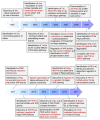The history and regulatory mechanism of the Hippo pathway
- PMID: 29397869
- PMCID: PMC5882217
- DOI: 10.5483/bmbrep.2018.51.3.022
The history and regulatory mechanism of the Hippo pathway
Abstract
How the organ size is adjusted to the proper size during development and how organs know that they reach the original size during regeneration remain long-standing questions. Based on studies using multiple model organisms and approaches for over 20 years, a consensus has been established that the Hippo pathway plays crucial roles in controlling organ size and maintaining tissue homeostasis. Given the significance of these processes, the dysregulation of the Hippo pathway has also implicated various diseases, such as tissue degeneration and cancer. By regulating the downstream transcriptional coactivators YAP and TAZ, the Hippo pathway coordinates cell proliferation and apoptosis in response to a variety of signals including cell contact inhibition, polarity, mechanical sensation and soluble factors. Since the core components and their functions of the Hippo pathway are evolutionarily conserved, this pathway serves as a global regulator of organ size control. Therefore, further investigation of the regulatory mechanisms will provide physiological insights to better understand tissue homeostasis. In this review, the historical developments and current understandings of the regulatory mechanism of Hippo signaling pathway are discussed. [BMB Reports 2018; 51(3): 106-118].
Conflict of interest statement
The authors have no conflicting interests.
Figures



References
-
- Twitty VCS, Josep L. The growth of eyes and limbs transplanted heteroplastically between two species of Amblystoma. J Exp Zool. 1931;59:61–86. doi: 10.1002/jez.1400590105. - DOI
Publication types
MeSH terms
Substances
LinkOut - more resources
Full Text Sources
Other Literature Sources
Molecular Biology Databases

